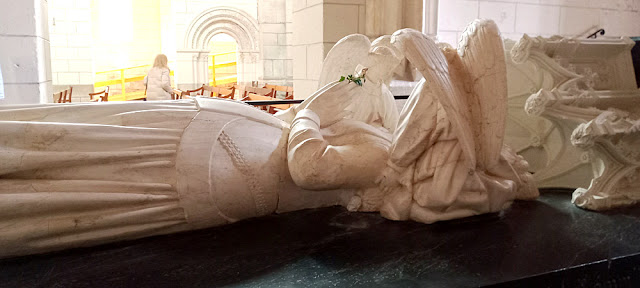There is currently a big temporary exhibition on Art in the Time of Charles VII at the Cluny Museum of Medieval Art in Paris. The star piece was to have been the alabaster tomb effigy (Fr. gisant) of Agnes Sorel, 15th century mistress of Charles VII. Her permanent home is the church of Saint Ours in Loches and she has never been lent before. As it turns out, neither is she this time, despite everyone's best intentions.
The statue was commissioned by Charles VII in 1450 when his beloved Agnes died suddenly at the age of 28. Forensic investigations of her remains in 2004 revealed that the cause of death was undoubtedly mercury poisoning, but whether it was accidental or deliberate murder is impossible to say for sure.
On 19 February a group of specialist art transporters arrived to pack her up and take her to Paris. The effigy alone weighs a bit over 200 kg, quite apart from the black marble slab she lays on, and the conservator assigned to oversee the job was nervous, just because of the prestige of the sculpture.
Despite all possible care being taken, an old crack started to open up as the team began to manipulate the sculpture and lifting it by just a few millimetres. Like many tomb monuments of this type, the effigy was badly damaged in 1793 during the Revolution. She lost her hands, a prayerbook she had been holding and reading, the canopy over her head, and the sculpture was shattered into several pieces. She was put back together in the 19th century and new hands added (now meeting in pious prayer and without the book). The break at her waist was repaired and during a conservation restoration in 2015 remained stable. But the museum and heritage professionals present were shocked to see how much it started to open up during the recent activity. The effigy was clearly much more fragile than they had expected.
Several solutions were tried, including inflatable supports, but moving her was finally deemed too risky. The preparations and loan negotiations for the exhibition had been going on for a year prior to this, so it was a hard decision to have to make.
The Loches town council were hoping that the focus on Agnes would lead to good publicity with the potential for a higher profile for this lovely rural town that is just a bit too far off the current Loire Valley tourist trail.
The exhibition at the Cluny runs from 12 March to 16 June. But if you want to see Agnes you will have to come to Loches. The Cluny's reaction to this blow was extremely gracious and professional. They understand the objects in loan arrangements like this can never be put at risk, and as the borrower, they had the legal and financial burden of responsibility for the operation. But it means a frantic last minute rearrangement of the exhibition for them, and because of the short time frame, no other image of Agnes Sorel will be on display. There will however be illuminated manuscripts, paintings, sculptures, goldsmithing work, stained glass, and tapestries to flesh out this often overlooked period. The exhibition hopes to show how the innovative Flemish style blended in France with the Italian awareness of their antiquities, creating a distinctive aesthetic ideal, particularly in the Loire Valley with the influential presence of Jean Fouquet.
I have to say that I am rather relieved. She is a major part of my presentation of the Royal Citadel when I do tours of Loches and to have had to say to clients that the star attraction was away on loan for the whole spring would have been a bit disappointing.
For now, the crack in Agnes's side is very visible, but a conservator will be commissioned to make an aesthetic repair.



No comments:
Post a Comment